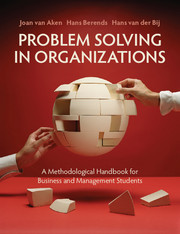Book contents
- Frontmatter
- Contents
- Figures
- Tables
- Boxes
- Preface
- Part I Fundamentals
- 1 Scope and nature of this handbook
- 2 Student projects
- 3 Problem solving projects
- 4 Designs and designing
- 5 Problem solving projects to develop generic theory
- Part II The Problem Solving Project
- Part III Methods
- Part IV Case Material
- References
- Author index
- Index
3 - Problem solving projects
from Part I - Fundamentals
- Frontmatter
- Contents
- Figures
- Tables
- Boxes
- Preface
- Part I Fundamentals
- 1 Scope and nature of this handbook
- 2 Student projects
- 3 Problem solving projects
- 4 Designs and designing
- 5 Problem solving projects to develop generic theory
- Part II The Problem Solving Project
- Part III Methods
- Part IV Case Material
- References
- Author index
- Index
Summary
Introduction
In Chapter 2 we saw that student field projects in business and management can be based either on the empirical cycle, aimed at developing descriptive or explanatory knowledge, or on the problem solving cycle, aimed at developing solutions for field problems. For the remainder of this handbook we discuss the methodology for the second type of project: the problem solving project. It is a design-oriented and theory-informed methodology. There are, of course, other problem solving strategies, and our methodology is not necessarily the best one for each and every business or organizational problem; it has a particular domain of application.
In this chapter we discuss first the foundations of this methodology and the types of field problems for which this methodology is appropriate. Then we discuss the nature of the problem solving project and its basic set-up, and we conclude by presenting the characteristics of professionally executed field problem solving projects, which are quite different from projects that aim to produce descriptive and explanatory knowledge.
Rational problem solving
This design-oriented and theory-informed methodology for business and organizational problem solving builds on the traditions of rational problem solving (Visscher and Visscher-Voerman, 2010). Systematic enquiry into problem solving, aimed at uncovering general principles, started with the work of Herbert Simon, Allen Newell and colleagues in the 1950s (see, for example, Newell and Simon, 1972). Their work strongly influenced research in cognitive science, artificial intelligence, management science and economics. A related stream of research developed on organizational decision-making, which was, in its formative years of the 1960s and 1970s, predominantly rational in orientation (see, for example, Simon, 1960). An especially representative example of this approach is the book by Kepner and Tregoe (1981). However, our design-oriented methodology differs from this rational problem solving or decision-making approach in two significant aspects.
Information
- Type
- Chapter
- Information
- Problem Solving in OrganizationsA Methodological Handbook for Business and Management Students, pp. 24 - 41Publisher: Cambridge University PressPrint publication year: 2012
